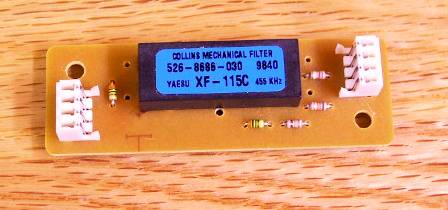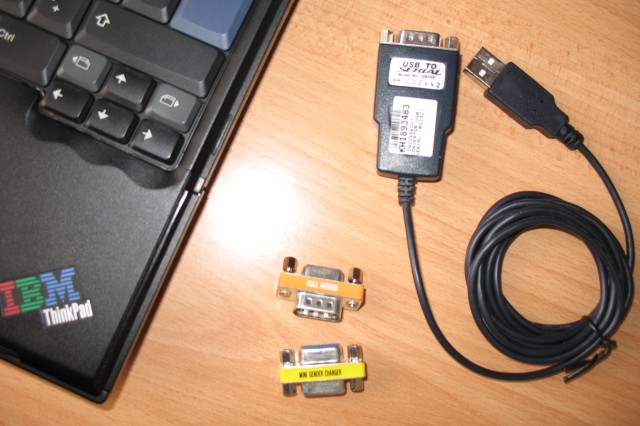The HF front stage uses a 2SC3356 low noise amplifier transistor.
2SC3356
The UHF front stage uses a 2SK2685 GaAs HEMT.
- Mixer stage
Quad-FET mixer GN2011-Q
TX chain
Filters
The muRata ceramic filters
The FT-847 comes from factory with two CFJ455K14 ceramic filters: one within receiver
chain and one within transmitter chain.
| Part number | Center frequency (KHz) | 6 dB Bandwidth (KHz) min | Ripple (dB) max | 60 dB Bandwidth (KHz) max | Spurios 0.1-1MHz dB (min) | Insertion loss (dB) max | Input/Output impedance (Ω) |
| CFJ455K14 | 455 | 2.2-2.6 | 2 | 4.5 (total) | 60 (40 at 600-750KHz | 7 | 2000 |
Note: Ripple definition range is within 3 dB bandwidth mentioned
in the standards list whenever the 3 dB bandwidth standard is provided.
It is within a 6 dB bandwidth mentioned in the standard list whenever 3 dB bandwidth
is not provided.
One of the sources for the above numbers you may find here.
The Rockwell Collins symmetrical torsional mechanical filters for SSB used as replacement for the ceramic filters
These filters are optional. They can be installed in the transceiver, replacing the ceramic ones, having an input/output impedance is 2000 ohms//30pF and a shape factor better than muRata CFJ455K14 shape factor. This means a better selectivity to the skirts level (-60dB), helpful during the crowded band conditions.
Yaesu Collins YF-115S-02 2,4 Khz @ 3 dB SSB Mechanical filter is used in the FT-847 and FT-1000MP Mark V (maybe some others, too).
|
Carrier |
Filter Bandwidths (KHz) |
Loss |
Number of Resonators |
Case Style |
Part Number |
|||||
|
Frequency (kHz) |
Min. BW |
@ |
dB |
Max. BW |
@ |
dB |
Max (dB) |
|||
|
455.00 |
2.40 |
@ |
3 |
5.20 |
@ |
60 |
5 |
8 |
PS |
526-8694-010 |
Plots for this filter are available here and the specifications can be downloaded from here.
There is also available a bit wider filter, with 2,5 KHz @ 3dB, which has written on the label YF-115S, as shown in the following picture.
Carrier
Filter
Bandwidths (KHz)
Loss
Number of
Resonators
Case
Style
Part
Number
Frequency
(kHz)
Min.
BW
@
dB
Max.
BW
@
dB
Max
(dB)
455.00
2.50
@
3
5.50
@
60
5
8
PS
526-8700-010
The Rockwell Collins symmetrical torsional mechanical filters for CW
The CW filter, YF-115C, has a bandwidth of
500 Hz @ 3 dB and it is a must when you like operating CW.
After my opinion, is one of the options which worth all the money.
|
Carrier |
Filter Bandwidths (KHz) |
Loss |
Number of Resonators |
Case Style |
Part Number |
|||||
|
Frequency (kHz) |
Min. BW |
@ |
dB |
Max. BW |
@ |
dB |
Max (dB) |
|||
|
455.00 |
0.450 |
@ |
3 |
2.00 |
@ |
60 |
5 |
7 |
PS |
526-8686-030 |

Where to read about FT-847
One of the places containing good information and almost all links about FT-847 is the
DH1NGP - Peter's web site.
Software control
To control the FT-847, I'm using an IBM laptop (which hasn't a serial port), a USB to serial adapter followed by a RS-232 null adapter and gender changer. The set-up can be seen here.

One simple “plug and play” soundcard interface for the Yaesu FT-847 is the one designed by Bill Ellis N5ZTW. It allows a full PTT switching and
CAT functions from a single serial port. The schematic is available on the internet. Few other designs are available.
A convenient free software package is the well known Ham Radio Deluxe which initially was written by Simon HB9DRV and Peter PH1PH (SK),
This provides the basic control of the transceiver.
under construction......
December 2011
Unfortunately, HRD has not yet a graphical interface for FT-847.
Are also other available software packages for CAT, but until now I had not any opportunity to use them.